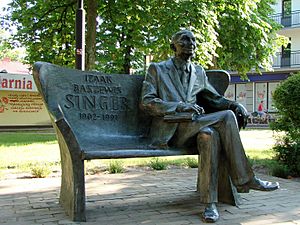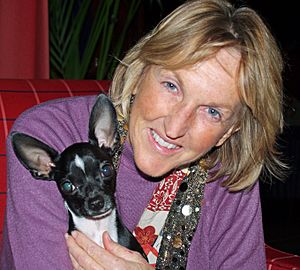Holocaust analogy in animal rights facts for kids
Some people and groups have noticed similarities between how animals are treated and the terrible events of the Holocaust. These comparisons started after World War II, when writers, many of whom were Holocaust survivors or Jewish, began to talk about how animals are treated by humans and how prisoners were treated in Nazi camps. A famous example is the 1968 short story The Letter Writer by Isaac Bashevis Singer. However, groups that fight against antisemitism, like the Anti-Defamation League (ADL) and the United States Holocaust Memorial Museum, have criticized these comparisons, especially after 2006 when PETA started using them a lot in their campaigns for animal welfare.
Contents
Why Some People Make This Comparison

One of the first people to make this comparison was Edgar Kupfer-Koberwitz. He was a German journalist who survived the Dachau Concentration Camp. In 1940, he wrote in his "Dachau Diaries" that because he had suffered so much, he could understand the suffering of other creatures. He believed that as long as people hurt and kill animals, they will also hurt and kill other humans. He felt that wars happen because killing is practiced on a smaller scale first.

Another Holocaust survivor, Alex Hershaft, who is now a vegan activist, has also compared the treatment of farm animals to the Holocaust. He said that we should focus on the idea of oppression itself, not just the victims. He noticed shocking similarities between what the Nazis did to his family and what humans do to animals raised for food. He pointed out things like branding animals with numbers, using crowded trains to move them, and keeping them in small crates. He also mentioned the idea of deciding who lives and who dies, like how Nazis decided Jews would die, or how people decide pigs will die but dogs will live.
The Polish-American author Isaac Bashevis Singer, who won the Nobel Prize in Literature in 1978, made this comparison in several of his stories. In his 1968 story The Letter Writer, a character says, "In relation to [animals], all people are Nazis; for the animals, it is an eternal Treblinka." In another story, The Penitent, a character states that "when it comes to animals, every man is a Nazi."
J. M. Coetzee, a writer from South Africa and Australia who won the Nobel Prize in Literature in 2003, spoke about how the Nazis treated Jewish people. He said that in the 20th century, powerful men in Germany decided to use methods from industrial slaughterhouses, like those in Chicago, to kill humans. They called it "processing" human beings.
In her 2005 book, The Holocaust and the Henmaid's Tale: A Case for Comparing Atrocities, animal rights activist Karen Davis argued that the horrors of the Holocaust and how animals are treated today can and should be compared. She believes this can help people understand something they might not want to hear about. She feels that many people don't see the comparison because the Holocaust is seen as a unique historical event, while animal suffering is so common that people don't even see killing animals as violence. She quoted Matt Prescott, who created PETA's "Holocaust on your Plate" campaign. Prescott said, "Holocaust victims WERE treated like animals, and so logically we can conclude that animals are treated like Holocaust victims."
In 2014, philosopher and animal rights activist Steven Best suggested that using the phrase "animal holocaust" can help show the huge amount of violence humans cause animals. He noted that hundreds of billions of land and water animals are killed each year just for food. He also said that conditions on large animal farms often look like the production lines in concentration camps. Animals are forced to produce a lot of meat, milk, and eggs, through being kept in small spaces and even through chemical changes. This forced work, like in Nazi camps, ends in death.
Belgian writer Marguerite Yourcenar wrote that if people had not accepted the cruel transportation of animals to slaughterhouses, they might not have accepted the transportation of humans to concentration camps. She also wrote that every act of cruelty suffered by thousands of living creatures is a crime against humanity.
American animal rights activist Gary Yourofsky compared factory farms to concentration camps. He said that Jewish people were treated as if their lives didn't matter, and animals still are. He suggested that if you remove the animals from a cow or pig slaughterhouse and replace them with humans, you would have recreated a place like Birkenau.
The ADL has also listed several animal rights groups that have made this comparison. No Compromise, a website for extreme animal liberation activists, compared the actions of the Animal Liberation Front to those who destroyed the gas chambers of Buchenwald and Auschwitz.
PETA's Campaigns and Images

In 2006, Ingrid Newkirk, the president of PETA, said: "Six million Jews died in concentration camps, but six billion broiler chickens will die this year in slaughterhouses." She said this as part of PETA's "Holocaust on Your Plate" campaign. This campaign included an exhibition with eight large panels. Each panel showed pictures of the Holocaust next to pictures of animals on factory farms. For example, photos of concentration camp prisoners were shown next to photos of chickens kept in small cages. A Jewish person who wanted to remain anonymous paid for the exhibition. It was created by Matt Prescott, whose family members died in the Holocaust. Prescott stated that "what Jews and others went through in the Holocaust is what animals go through every day in factory farms."
This exhibition was strongly criticized by Abraham Foxman, who was the chairman of the ADL. He called the exhibition "outrageous" and "offensive." He felt that PETA's effort to compare the planned killing of millions of Jews to animal rights was terrible. Stuart Bender, a lawyer for the United States Holocaust Memorial Museum, asked PETA to stop using Holocaust materials in this way. Even Alex Hershaft, a Holocaust survivor who had used the comparison himself, criticized PETA's campaign. He felt PETA was using the comparison too carelessly. He said that he only made the comparison when asked, and he did it very carefully, sharing it as part of his own story and what he learned from it.
In 2005, Newkirk apologized for any pain the campaign caused, but she still defended its goals. The Guardian newspaper reported that Newkirk's comments did not calm the anger of Jewish groups. The campaign was also banned in Germany because it made the Holocaust seem "insignificant."
Why Some People Criticize the Comparison
Concerns About Antisemitism
The ADL says that when animal rights activists use images from the Holocaust, it is "disturbing" and can be seen as antisemitic. Roberta Kalechofsky from Jews for Animal Rights wrote that while there might be some connection between animal suffering and the Holocaust, they are very different historical events. She believes that comparing them weakens the strong message against antisemitism. Holocaust survivor Abraham Silverman said that the comparison is offensive. He felt it lessens the suffering of Jewish people during World War II and encourages antisemitism online.
However, Alex Hershaft, who is Jewish and a Holocaust survivor, said he doesn't take accusations of antisemitism seriously. He added, "The main criticism is that we're making light of the sacrifice of the Holocaust, and of course, we're not. Far from it. We're honoring it by trying to draw some lessons for humanity."
See also
 In Spanish: Derechos de los animales y el Holocausto para niños
In Spanish: Derechos de los animales y el Holocausto para niños

